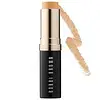What's inside
What's inside
 Key Ingredients
Key Ingredients

 Benefits
Benefits

 Concerns
Concerns

 Ingredients Side-by-side
Ingredients Side-by-side

Caprylic/Capric Triglyceride
MaskingEthylhexyl Palmitate
EmollientCetyl Dimethicone
EmollientPolymethylsilsesquioxane
Ozokerite
Emulsion StabilisingEuphorbia Cerifera Wax
Butyrospermum Parkii Butter
Skin ConditioningTalc
AbrasiveOctyldodecanol
EmollientCaprylic/Capric/Myristic/Stearic Triglyceride
EmollientSilica
AbrasivePropylene Glycol Laurate
Skin ConditioningTocopherol
AntioxidantSqualane
EmollientPentaerythrityl Tetra-Di-T-Butyl Hydroxyhydrocinnamate
AntioxidantMica
Cosmetic ColorantCI 77491
Cosmetic ColorantCI 77492
Cosmetic ColorantCI 77499
Cosmetic ColorantCI 77891
Cosmetic ColorantCaprylic/Capric Triglyceride, Ethylhexyl Palmitate, Cetyl Dimethicone, Polymethylsilsesquioxane, Ozokerite, Euphorbia Cerifera Wax, Butyrospermum Parkii Butter, Talc, Octyldodecanol, Caprylic/Capric/Myristic/Stearic Triglyceride, Silica, Propylene Glycol Laurate, Tocopherol, Squalane, Pentaerythrityl Tetra-Di-T-Butyl Hydroxyhydrocinnamate, Mica, CI 77491, CI 77492, CI 77499, CI 77891
Ethylhexyl Methoxycinnamate 6.7%
UV AbsorberTitanium Dioxide 1.6%
Cosmetic ColorantWater
Skin ConditioningDimethicone
EmollientGlycerin
HumectantTrimethylsiloxysilicate
EmollientCetyl PEG/PPG-10/1 Dimethicone
EmulsifyingButylene Glycol
HumectantPolymethylsilsesquioxane
Polyglyceryl-3 Diisostearate
EmulsifyingSodium Chloride
MaskingAcetyl Glucosamine
Skin ConditioningDisteardimonium Hectorite
StabilisingLaminaria Saccharina Extract
Skin ProtectingLavandula Angustifolia Oil
MaskingLavandula Hybrida Oil
EmollientHoney Extract
HumectantButyl Avocadate
Skin ConditioningCaprylyl Glycol
EmollientDisodium Stearoyl Glutamate
CleansingSodium Hyaluronate
HumectantSalicylic Acid
MaskingMethoxy Amodimethicone/Silsesquioxane Copolymer
Skin ConditioningAluminum Hydroxide
EmollientSilica
AbrasivePentaerythrityl Tetra-Di-T-Butyl Hydroxyhydrocinnamate
AntioxidantPolysilicone-11
Citric Acid
BufferingSodium Hydroxide
BufferingHexylene Glycol
EmulsifyingStearic Acid
CleansingLinalool
PerfumingLinalyl Acetate
MaskingBHT
AntioxidantTocopheryl Acetate
AntioxidantDisodium EDTA
Phenoxyethanol
PreservativeMica
Cosmetic ColorantCI 77891
Cosmetic ColorantCI 77491
Cosmetic ColorantCI 77492
Cosmetic ColorantCI 77499
Cosmetic ColorantEthylhexyl Methoxycinnamate 6.7%, Titanium Dioxide 1.6%, Water, Dimethicone, Glycerin, Trimethylsiloxysilicate, Cetyl PEG/PPG-10/1 Dimethicone, Butylene Glycol, Polymethylsilsesquioxane, Polyglyceryl-3 Diisostearate, Sodium Chloride, Acetyl Glucosamine, Disteardimonium Hectorite, Laminaria Saccharina Extract, Lavandula Angustifolia Oil, Lavandula Hybrida Oil, Honey Extract, Butyl Avocadate, Caprylyl Glycol, Disodium Stearoyl Glutamate, Sodium Hyaluronate, Salicylic Acid, Methoxy Amodimethicone/Silsesquioxane Copolymer, Aluminum Hydroxide, Silica, Pentaerythrityl Tetra-Di-T-Butyl Hydroxyhydrocinnamate, Polysilicone-11, Citric Acid, Sodium Hydroxide, Hexylene Glycol, Stearic Acid, Linalool, Linalyl Acetate, BHT, Tocopheryl Acetate, Disodium EDTA, Phenoxyethanol, Mica, CI 77891, CI 77491, CI 77492, CI 77499
Ingredients Explained
These ingredients are found in both products.
Ingredients higher up in an ingredient list are typically present in a larger amount.
Ci 77491 is also hydrated iron III oxide. It's sole purpose is to give a red/pink hue to products.
Iron III oxides are classified as inorganic chemicals for coloring.
Synthetically created Ci 77491 is considered safer than those naturally found. This is because the synthetically created version may contain less impurities. Iron oxides are generally non-toxic and non-allergenic.
Learn more about CI 77491Ci 77492 is also hydrated iron III oxide. It's sole purpose is to give a yellow hue to products.
Iron III oxides are classified as inorganic chemicals for coloring.
Synthetically created Ci 77492 is considered safer than those naturally found. This is because the synthetically created version may contain less impurities. Iron oxides are generally non-toxic and non-allergenic.
Learn more about CI 77492Ci 77499 is also hydrated iron III oxide. It is created from mixing red and black iron oxides. This helps give shades of darkness to a product.
Iron III oxides are classified as inorganic chemicals for coloring.
Ci 77891 is a white pigment from Titanium dioxide. It is naturally found in minerals such as rutile and ilmenite.
It's main function is to add a white color to cosmetics. It can also be mixed with other colors to create different shades.
Ci 77891 is commonly found in sunscreens due to its ability to block UV rays.
Learn more about CI 77891Mica is a naturally occurring mineral used to add shimmer and color in cosmetics. It can also help improve the texture of a product or give it an opaque, white/silver color.
Serecite is the name for very fine but ragged grains of mica.
This ingredient is often coated with metal oxides like titanium dioxide. Trace amounts of heavy metals may be found in mica, but these metals are not harmful in our personal products.
Mica has been used since prehistoric times throughout the world. Ancient Egyptian, Indian, Greek, Roman, Aztec, and Chinese civilizations have used mica.
Learn more about MicaPentaerythrityl Tetra-Di-T-Butyl Hydroxyhydrocinnamate (long name, huh?) is a synthetic antioxidant.
It is used to help stabilize other antioxidants or prevent the color from changing in a product.
As an antioxidant, it helps fight free-radical molecules. Free-radical molecules are capable of damaging our cells and other genetic material. Thus, antioxidants may reduce the signs of aging.
This ingredient is oil-soluble.
Learn more about Pentaerythrityl Tetra-Di-T-Butyl HydroxyhydrocinnamatePolymethylsilsesquioxane is a silicone used as a film forming agent.
When applied to the skin, this ingredient creates an invisible film on the surface. This film still allows oxygen to pass through, but prevents moisture from escaping. This can help condition and hydrate the skin. It also leaves a silky feel when applied.
Polymethylsilsesquioxane has not been shown to clog pores. It has been deemed safe to use up to 55%, but most cosmetics use much less.
If you have concerns about using this ingredient, we recommend speaking with a professional.
Learn more about PolymethylsilsesquioxaneSilica, also known as silicon dioxide, is a naturally occurring mineral. It is used as a fine, spherical, and porous powder in cosmetics.
Though it has exfoliant properties, the function of silica varies depending on the product.
The unique structure of silica enhances the spreadability and adds smoothness, making it a great texture enhancer.
It is also used as an active carrier, emulsifier, and mattifier due to its ability to absorb excess oil.
In some products, tiny microneedles called spicules are made from silica or hydrolyzed sponge. When you rub them in, they lightly polish away dead skin layers and enhance the penetration of active ingredients.
Learn more about Silica